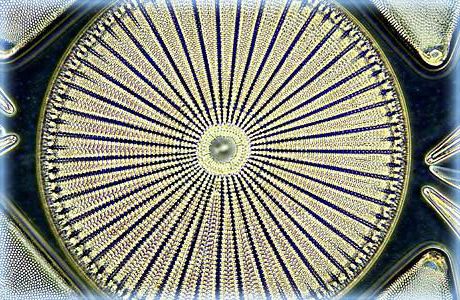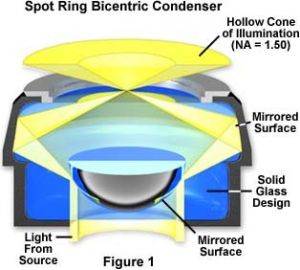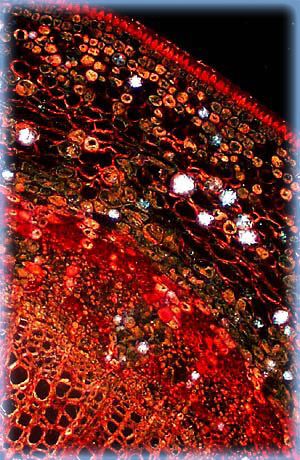Darkfield microscopy is a technique that takes advantage of oblique illumination to enhance contrast in specimens that are not imaged well under normal illumination conditions.
After the direct light has been blocked by an opaque stop in the condenser, light passing through the specimen from oblique angles is diffracted, refracted, and reflected into the microscope objective to form a bright image of the specimen superimposed on a dark background.
This dark background provides a high degree of contrast and can make samples with difficult backgrounds stand out with relatively little effort. Check out some examples in the images below.
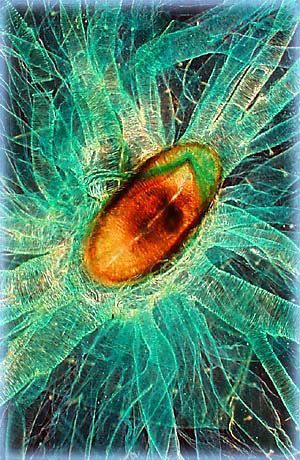
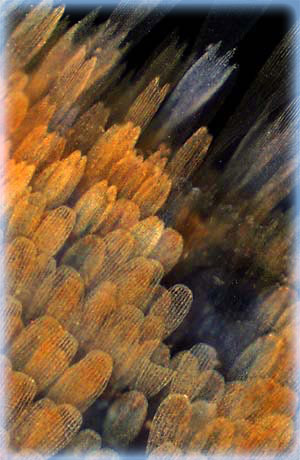
Right: silkworm larva spiracle and trachea. Tiny pieces of fragmented wood take on an unusually beautiful appearance when illuminated under darkfield conditions with a transmitted light microscope.
Left: butterfly. Butterflies, because of the wide spectrum of wing scale patterns exhibited by members of this order, are one of the most colorful members of the insect world. The digital image shows the many miniature scales that decorate most of a butterfly wing’s surface. The wing scales were illuminated with a darkfield substage condenser and captured at low magnification (50x).
How Does Darkfield Microscopy Work?
Darkfield illumination requires blocking most of the light that ordinarily passes through and around the specimen, allowing only oblique rays to interact with the specimen.
The top lens of a simple Abbe darkfield condenser is spherically concave, allowing light rays emerging from the surface of the top lens to form an inverted hollow cone of light with the focus centered on the specimen plane. In places where there is no sample and the condenser’s numerical aperture is greater than the objective’s, the oblique rays cross each other and miss the objective, leaving those areas dark.
When a specimen (especially an unstained, non-light absorbing one) is placed on a slide, the oblique rays interact with the specimen and are diffracted, reflected, and/or refracted by elements in the sample, such as the cell membrane, nucleus, and internal organelles. This allows these faint rays to enter the objective. The result is a bright specimen on a black background.
What Components Are Necessary for Darkfield Microscopy?
Almost any brightfield laboratory microscope can be easily converted to perform darkfield illumination. The easiest way to do this is to switch out your current condenser with one that is designed for darkfield illumination (Figure 1).
These condensers are relatively simple and offer the high numerical aperture (NA) required to create the cone of illumination needed for darkfield. Yet, switching condensers based on the illumination type is impractical for everyday microscope use. Luckily, there’s a workaround.
Many condensers can accommodate inserts that can create a cone of illumination. These inserts don’t offer an NA as high as a dedicated darkfield condenser, so not all objectives can be used. However, the inserts give you the flexibility to have multiple observation methods on the same condenser.
Why Is Darkfield Microscopy a Good Imaging Technique?
In general, objects imaged under the proper conditions of darkfield illumination are spectacular to see. Often, specimens containing very low inherent contrast in brightfield microscopy shine brilliantly in darkfield.
Darkfield illumination is best for revealing outlines, edges, boundaries, and refractive index gradients. Ideal candidates for darkfield illumination include minute living aquatic organisms, diatoms, small insects, bone, fibers, hair, unstained bacteria, yeast, cells in tissue culture, and protozoa.
Non-biological specimens include mineral and chemical crystals, colloidal particles, dust-count specimens, and thin sections of polymers and ceramics containing small inclusions, porosity differences, or refractive index gradients.
Here are some examples of specimens captured using darkfield imaging:
Unfortunately, darkfield illumination is less useful for revealing internal details. There are also other conditions to consider if you want to make the most out of darkfield illumination.
What Are the Challenges of Using Darkfield Microscopy?
Care must be taken when preparing specimens for darkfield microscopy because the features that lie above and below the plane of focus can scatter light and contribute to image degradation. The cleanliness of the slide is an important factor when imaging, but it is even more important in darkfield since every piece of debris will be illuminated and can take away from what you’re trying to see.
Other challenges you might face when setting up a microscope for darkfield include:
Insufficient illumination to make the specimen visible, or the specimen is visible but very faint.
Darkfield microscopy takes a lot of light to image properly because so much of it is blocked to form the cone. So, don’t hesitate to turn up the power, but be aware that some samples may not like that amount of light on them for prolonged periods of time.The slide has a dark spot in the center of the field of view, but objects in the periphery are well illuminated and appear normal.
This is normally caused when the condenser is improperly aligned or focused. Centering and focusing the condenser will address this issue. This solution applies to most issues where illumination appears uneven but the sample is in focus.Colors appear in the background, or the background is unevenly lit with a gray cast.
This is often the result of the sample being too thick or mounted in contaminated media. Remounting the sample should help.
What Are the Advantages of Using Darkfield Microscopy?
Darkfield microscopy has many advantages. Its dark background offers a high degree of contrast, making it easy to see samples on difficult backgrounds. This technique is easily accessible since many brightfield lab microscopes can be configured for darkfield illumination. Besides the microscopy benefits, darkfield images can even look like works of art with the sample beautifully illuminated.
Related Content
Stereo Microscope Primer: Transmitted Light Observation Methods
From Multimode Imaging to Multiplexing: Your Essential Guide to Extracting Rich Data
Optimize Observation and Contrast Methods with One Stereo Microscope Base
